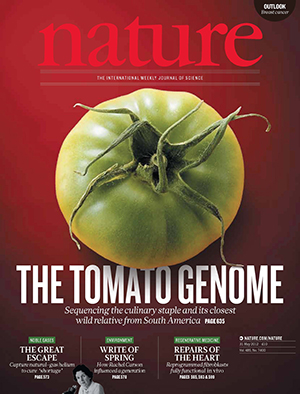Tomato Genome Now Known
By Dr Rizwana Rahim
Chicago, IL
Call it vegetable or fruit, but remember that tomato’s genetic code has now been almost fully sequenced by a huge international scientific team effort.
What does this mean to the people who like tomatoes but may also have some complaints about what they get in the market?
Scientists now think that, by maneuvering or modifying their genes, they may soon be able to produce better-tasting tomatoes, with more nutrition, longer shelf-life, less vulnerable to its pests in the field, using less (or no) pesticides and less of their residue on the fruit we consume. Genetically modified tomatoes can also be made to grow in different climatic and soil conditions, with higher yields.
This massive research project was undertaken 9 years ago by the international Tomato Genome Consortium with the help of more than 300 scientists from 14 different countries including US, UK, several Europeans and Asian countries (India, China, Japan, South Korea) and Israel. The team was led by Giovanni Giuliano (an Italian scientist, also referred to as Jim Giovanni, now associated with Boyce Thompson Institute for Plant Research on the campus of Cornell University, Ithaca, NY) and Dani Zamir, Hebrew University, Jerusalem, Israel.
They sequenced the genome of ‘Heinz 1706’ tomato (Solanum lycopersicum, a domesticated tomato of Ketchup fame) and compared it with that of its closest wild relative from Peru, Solanum pimpinellifolium. They also compared these two tomato genomes to that of potato (Solanum tuberosum), a tuber belonging to the same Solanum family. The results were published a few days ago in the prestigious British journal, Nature 485: 635-641, May 31, 2012.
They found that tomato has 31,760 genes, arranged on 12 chromosomes. They also found very little difference between the two tomato species (about 0.6% divergence in their nucleotides) but with the potato genome, there was more than 8% divergence, with some inversions (9 large and several small).
This tomato genetic sequence, the scientists involved think, is “amazingly complete.” Given that more than 80% of tomato genome is sequenced and over 90% of genes in it identified (with refinements underway), a scientist familiar with the work says, "It's one of the better genomes out there."
Another remarkable discovery is of evolutionary significance. It seems the
entire tomato genome was ‘triplicated’, twice in the past 100 million years. First event happened about 130 million years ago (first identified in grapes, Vitis vinifera) and the other about 60 million years ago. The second event had great influence on the development of tomato as fruit because, Giovannoni thinks, “several of the genes ‘born’… stayed in the genome for tens of millions of years, [and] then, relatively recently, they changed their function — this brought about the appearance of the fleshy fruit as we know it today.” Since the tomato is used as a research model for the development of fleshy fruit, this information will also be useful in breeding other fruits, such as melons, bananas, strawberries.
Contrary to what one may expect, triplication of genome in a plant or an organism (i.e., carrying 3x more DNA as it really needs) is not really an advantage. Two extra copies would be free to undergo mutations, and many genes in them may not be of any use and either dropped or develop for other functions.
Tomato has about 7,000 more genes than in humans. This does not mean or imply that tomato is genetically more advanced or sophisticated. Rather, in humans, highly complicated, ‘alternative splicing’ mechanisms occur, by which different parts of each gene are re-assembled by various ways, making one gene code for not just one but many different products.
Approximately 146 million tons of tomatoes were reportedly produced globally in 2010. Its market in the US alone is $2 billion and, according to the USDA estimates, Americans, individually on the average, consume roughly 72 pounds of tomatoes per year. Other Solanaceae family members include pepper (Capsicum sp.), aubergines (Solanum melogena) , besides potato, and other spices and medicinal herbs.
Even though, the tomato genome cost millions of dollars, but based on the technology already used, researchers believe that similar sequences of other fruits may only cost $ 10,000 or less. Since tomatoes share their characteristics other fleshy fruits ( strawberries, apples, melons, bananas, etc), this information may be useful in their agriculture improvements.
Tomato has not been the first or only agricultural product whose genetic code has been unraveled. Other vegetables and fruits so sequenced include corn, wheat, rice, soybean, apple and strawberry. However, prior to such genetic modification of crops, many other traditional cross-breeding protocols have been in use for years.
Now returning to the tomato as a fruit (as most botanists think) or a vegetable (according to the US Supreme Court ruling in 1893, Nix vs Hedden), it became an issue again in 1980s during the debate on quality of food in US school cafeterias. Some rationale does exist for the court ruling if potato, a close relative of tomato, is considered a vegetable. Last year, when the Obama administration tried to change nutrition guidelines with regard to tomato paste, and the basic controversy remains over what tomato really is: a fruit or vegetable?
The prospects look better on all fronts because of this genetic research, but would tomatoes be any cheaper soon? I am not holding my breath!

-----------------------------------------------------------------------------
Back to Pakistanlink Homepage

